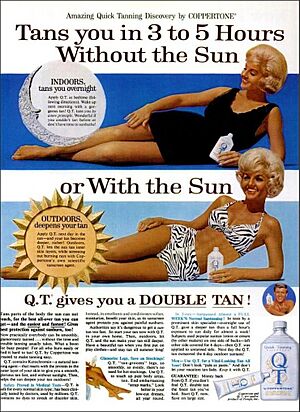Sunless tanning facts for kids
Sunless tanning is a way to make your skin look tan without needing to go out in the sun. It's also called self-tanning or fake tanning. You can get a sunless tan by using special creams, lotions, or sprays on your skin. Some products change your skin color temporarily, while others react with your skin to create a longer-lasting tan.
Sunless tanning became more popular in the 1960s. This happened after health experts found out that too much sun or indoor tanning can increase the risk of skin cancer.
Many sunless tanning products use a chemical called dihydroxyacetone (DHA). This chemical reacts with a protein in your skin called keratin. This reaction creates the tan color. Different amounts of DHA are used to make lighter or darker tan shades.
What Are Temporary Bronzers?
Bronzers are products that give your skin a temporary tan. They come in many forms, like powders, sprays, gels, or lotions. You put them on your skin, and they add color.
Bronzers are like makeup for your skin. They tint or stain your skin until you wash them off with soap and and water. People often use them for a "one-day" tan or to make a DHA-based tan look even better.
Some bronzers are made to resist sweat or light water. Ingredients like walnut oil extract or caramel are often used in these products. If you wear bronzer under clothes, it might rub off a little. Wearing dark clothes can help hide any rub-off. While bronzers are much safer than tanning beds, they can sometimes look orange or splotchy if not put on carefully.
A newer type of product is a lotion that gives you a tan slowly. You might see a little color after the first time you use it. The color gets darker the more often you use the product.
Airbrush tanning is another way to get a temporary tan. A professional sprays a special tanning solution onto your skin. This kind of tan can last for about five to ten days. It fades as your skin naturally sheds its cells. People often get airbrush tans for special events or when they want a quick, dark tan. You can also buy kits to do airbrush tanning at home.
Are There Any Risks?
Many self-tanners also contain sunscreen. However, it's important to know that the sunscreen in these products might not last all day. This means your skin could still be sensitive to the sun.
Some studies suggest that the DHA in self-tanners might make your skin more likely to get damaged by the sun. This damage comes from things called "free radicals." So, even if you use a self-tanner, it's still very important to wear regular sunscreen (SPF) when you go outside.
Scientists are also studying if breathing in the chemicals from spray tans could be harmful. Some experts are concerned that these chemicals might get into your bloodstream if you breathe them in. They are looking into whether these compounds could cause problems for cells.
Many self-tanners use chemical fragrances. These can sometimes cause skin allergies or trigger asthma in some people. Also, some products contain parabens. Parabens are preservatives, and some people worry they might affect how your body's systems work.
See also
- Indoor tanning
- Indoor tanning lotion
- Sun tanning


